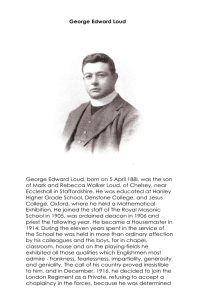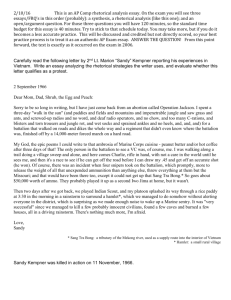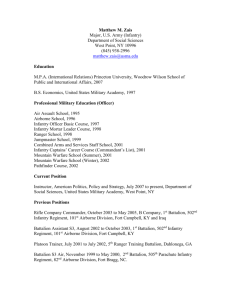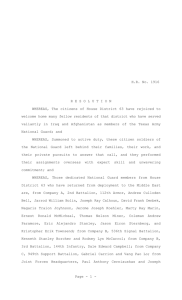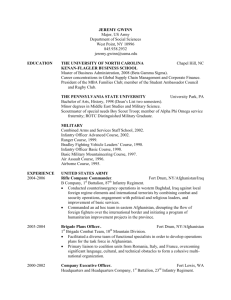a copy of this report in Microsoft Word format
advertisement
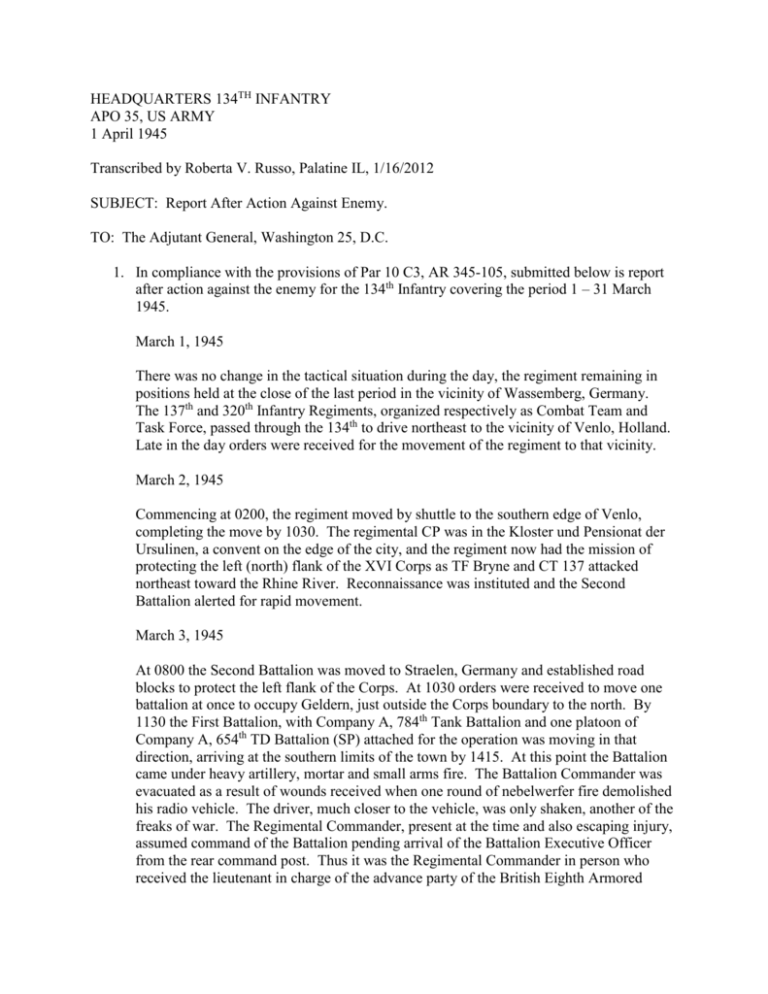
HEADQUARTERS 134TH INFANTRY APO 35, US ARMY 1 April 1945 Transcribed by Roberta V. Russo, Palatine IL, 1/16/2012 SUBJECT: Report After Action Against Enemy. TO: The Adjutant General, Washington 25, D.C. 1. In compliance with the provisions of Par 10 C3, AR 345-105, submitted below is report after action against the enemy for the 134th Infantry covering the period 1 – 31 March 1945. March 1, 1945 There was no change in the tactical situation during the day, the regiment remaining in positions held at the close of the last period in the vicinity of Wassemberg, Germany. The 137th and 320th Infantry Regiments, organized respectively as Combat Team and Task Force, passed through the 134th to drive northeast to the vicinity of Venlo, Holland. Late in the day orders were received for the movement of the regiment to that vicinity. March 2, 1945 Commencing at 0200, the regiment moved by shuttle to the southern edge of Venlo, completing the move by 1030. The regimental CP was in the Kloster und Pensionat der Ursulinen, a convent on the edge of the city, and the regiment now had the mission of protecting the left (north) flank of the XVI Corps as TF Bryne and CT 137 attacked northeast toward the Rhine River. Reconnaissance was instituted and the Second Battalion alerted for rapid movement. March 3, 1945 At 0800 the Second Battalion was moved to Straelen, Germany and established road blocks to protect the left flank of the Corps. At 1030 orders were received to move one battalion at once to occupy Geldern, just outside the Corps boundary to the north. By 1130 the First Battalion, with Company A, 784th Tank Battalion and one platoon of Company A, 654th TD Battalion (SP) attached for the operation was moving in that direction, arriving at the southern limits of the town by 1415. At this point the Battalion came under heavy artillery, mortar and small arms fire. The Battalion Commander was evacuated as a result of wounds received when one round of nebelwerfer fire demolished his radio vehicle. The driver, much closer to the vehicle, was only shaken, another of the freaks of war. The Regimental Commander, present at the time and also escaping injury, assumed command of the Battalion pending arrival of the Battalion Executive Officer from the rear command post. Thus it was the Regimental Commander in person who received the lieutenant in charge of the advance party of the British Eighth Armored Brigade moving down from the northwest. This sealed the first link-up of the two forces east of the Roer River at 1535. At 2000 the Battalion was in control of that portion of the town west of the canal, across which all bridges had been blown. Between 1400 and 1600 the Third Battalion had displaced to assembly in the vicinity of Straelen. At 1600, the 161st Field Artillery Battalion, less Battery A, reverted to Division Artillery control. March 4, 1945 Prior to dawn the First Battalion adjusted its positions to permit the British to pass through and continue the attack against the main portion of Geldern. Upon completion of this readjustment and passage of troops, the Battalion was reassembled, once more within the Corps zone. The Regiment was now in the general vicinity of Sevelen, with only Company G active as bridge guards on the main supply route. Company A, 784th Tk Battalion, Battery A, 161st Field Artillery Battalion and Company C, 89th Chemical Mortar Battalion were released from attachment, the combat team dissolved and the Regiment continued to constitute the Division reserve. March 5, 1945 There was no change in the tactical situation, with the regiment remaining in Division Reserve and Company G continuing the mission of bridge-guard on the main supply route. March 6, 1945 The troops were shifted to new areas in the vicinity of Horstgen and Oermter, with some elements remaining at Sevelen. Company G continued to guard the main supply route from Nieukerk to Horstgen. Staff Sergeant Junior J. Spurrier, Company G, was presented the Congressional Medal of Honor by the Ninth Army Commander, Lieutenant General William H. Simpson, at Kaldenkirchen, Germany, the XVI Corps command post. The award was for action at Achain, France during November, 1944, and was the first Congressional Medal of Honor in the Ninth Army. Sgt. Spurrier also holds the Distinguished Service Cross, the Purple Heart with cluster and has been recommended for the French Croix de Guerre. March 7, 1945 There was no change in tactical situation, the regiment remaining in Division reserve. March 8, 1945 During the afternoon orders were received to relieve elements of the 320th Infantry and reconnaissance instituted, but the relief was delayed twenty-four hours on Division order. March 9, 1945 The First Battalion was attached to the 320th Infantry until 2400 and moved to assembly as Regimental reserve for that unit. This released the Third Battalion of the 320th Infantry, which in turn relieved the Second Battalion of the 134th Infantry as bridge guards on the main supply route. Reconnaissance was continued for the relief of the remainder of the 320th Infantry and the continuation of the attack to the Rhine River opposite Wesel. The Second Battalion was to constitute Regimental reserve, with the Third and First attacking in column in that order. Company C, 18th Tank Battalion, 8th Armored Division, was attached for the operation. The relief of the 320th Infantry was complete by 2400. March 10, 1945 At 0615 the Third Battalion passed through the First Battalion, 320th Infantry, and attacked to the northeast to seize the town of Borth. The leading elements of Company L were reported on the outskirts of that town by 0720 and continued the attack to the northeast, while Company K cleared the town. Company L was on the second objective by 1247. At that time Company I, mounted on tanks, passed through Company L to seize Buderich, clearing that town of enemy by 1610. Late in the day the Third Battalion was sending patrols to the bridges over the Rhine River and the minor fortification of Fort Blucher, on the west bank of the river. Coincident with this action the First Battalion attacked at 0945 from the town of Millingen to seize an objective to the northeast. It was reported on its objective and sending patrols to the flanks for contact by 1255. Scattered enemy resistance, consisting mainly of mortar and artillery fire increasing in intensity in Buderich toward the end of the period. Contact and liaison was established with the 52nd British Division on the left. At the end of the period all German resistance west of the Rhine in the vicinity of Wesel had been overcome. The Second Battalion remained in Regimental reserve during the period. March 11, 1945 One platoon of Company I continued to advance and by 0900 had seized and outposted Fort Blucher. No other change in the tactical situation or disposition of the Regiment occurred during the day. During the afternoon elements of the Regiment, including the Regimental CP, were strafed by enemy planes, but no casualties were incurred. Plans were made for the relief of the Regiment by elements of the 157th British Brigade and the 290th Infantry. Control of the 18th Tank Battalion and Company C, 89th Chemical Battalion reverted to parent units. March 12, 1945 The Third Battalion was relieved by elements of the 157th British Brigade and assembled in the vicinity of Borth. The First Battalion was relieved by the First Battalion, 290th Infantry, 75th Division, and assembled in the vicinity of Millingen. At 1700 the combat team started a motor movement to the vicinity of Birholz, a move of about thirty-three miles. The entire Division was going into a rest area for the first time since landing in France. The Regimental CP was at Birholz, Germany, and all units closed into the area by 2030. March 13, 1945 Combat Team 134 was engaged in cleaning of billets, equipment and clothing. March 14, 1945 Rest and rehabilitation was the main effort, though a minimum of training was undertaken. At a meeting of Battalion and Special Unit Commanders, and the Regular and Special Staff, the Regimental Commander addressed the group relative to discipline, military courtesy, uniform appearance, and administrative matters. March 15, 1945 There was some small-arms firing for test and zero, but the stress was on rest and rehabilitation. March 16, 1945 There was no change in the tactical situation. At the Division Command Post in Kaldenkirchen, the Regimental Commander, Staff Sergeant Junior J. Spurrier, and Technician Grade IV Edward W. Thill were presented the Croix de Guerre by the French Chief-of-Liaison and the Division Commander. It is believed that with this award, Sgt. Spurrier became the only soldier in this war to hold the two highest individual honors of the United States and a foreign decoration. March 17, 1945 There was no change in the tactical situation. March 18, 1945 An inspection team from XVI Corps conducted a ten-percent inspection of all arms and vehicles. The officer in charge stated that the results of the inspection were highly satisfactory. (Satisfactory or unsatisfactory were the only ratings possible.) There was no change in the tactical situation. March 19, 1945 The tactical situation remained unchanged. The Regimental Commander and S-1 attended an Armored Conference and review of Operation “Grenade” held at the Ninth Army Headquarters in Munchen-Gladbach. The First Battalion conducted a retreat parade. March 20, 1945 The Second Battalion conducted a Retreat Parade. Still no change in the tactical situation. With a flag borrowed from the Division military government officer and on an extended power-line pole, the American flag was raised for what is believed to be the first time in this war over German soil. March 21, 1945 Orders were received assigning responsibility for an area slightly larger than the Regimental assembly area, and motor patrols were started and bridge guards established. The Third Battalion conducted a Retreat Parade. March 22, 1945 Anti-Tank Company held a formal guard mount and Retreat ceremony, with Cannon Company observing. Some units engaged in a ten-mile hike as a part of the limited training program. There was no change in the tactical situation. March 23, 1945 Continued rest and training. A commendation was received from the Ninth Army Commanding General for participation in Operation “Grenade”. The letter was dated 15 March 1945 and bore the indorsement of the XVI Corps Commander as well as that of the Division Commander. March 24, 1945 The Regimental Commander addressed all command and staff officers, including company commanders, and oriented them on the coming operation. Mid-morning the order was received for the S-1 billeting party to make a reconnaissance in the vicinity west of Wesel, and after 1700 the regiment was to be on a thirty-minute alert for movement. Area responsibility ended at 1515, (only to be reassigned at 2150). At 1609 the information was that the regiment would not move prior to 2400, and probably not before morning, 25 March. At 1845 the alert was changed to a four-hour status, with the probabilities unchanged. March 25, 1945 The Anti-Tank Company Mine Platoon, sweeping the proposed assembly area, was ordered to rejoin the company. At 1230 the S-1 billeting parties were alerted for movement within fifteen minutes. At 1340 all Battalion and Special Unit Commanders were ordered to the Regimental Command Post where the order was issued forming Task Force Miltonberger. At 1420, the Assistant Division Commander issued the order for the movement of TF Miltonberger to a forward detrucking area in the vicinity of Rhineberg. While the Task Force was moving to the detrucking point, the Regimental Command party went forward to the command post of the 79th Infantry Division, to which Task Force Miltonberger was attached for the operation. There the order was received for an immediate crossing of the Rhine River. Command and reconnaissance parties were sent forward as rapidly as possible. The troops were moved from the detrucking point and the first elements (Headquarters Company) crossed the river at 2000. The crossing was made on “Love” Bridge at “Blue” Beach near Rhineberg. Task Force Miltonberger at this time was composed of the 134th Infantry Regiment; 161st Field Artillery Battalion (105mm How.); 127th Field Artillery Battalion (155mm How.); Company A, 654th TD Battalion (SP); Company A, 60th Engineer (C) Battalion; Company A, 784th Tank Battalion; and Company A, 110th Medical Battalion (Collecting). March 26, 1945 The movement from the detrucking area west of Rhineberg to the vicinity of Dinslaken, east of the Rhine, was completed by 0500. After an early morning reconnaissance, the Task Force launched an attack at 0800 with the Third Battalion on the right and the Second Battalion on the left (north). The line of departure was the existing forward positions of the 315th Infantry, 79th Division. After being relieved, that organization turned generally southeast to protect the south flank of the Corps. The Third Battalion encountered moderate resistance, including considerable 20mm and direct-fire artillery, but by 1530 had advanced three and one-half kilometers to the Task Force objective, seizing the bridge across the Schwarzer River (376318) intact. The Second Battalion advanced rapidly, especially Company E on the left flank, against light opposition. Company G on the right flank of the Battalion encountered much the same type of opposition as the Third Battalion, and its advance was much in accord with that of the Third, but by 1242 both units were on the Task Force objective after having advanced four kilometers. The First Battalion remained in Task Force reserve throughout the period, advancing to positions generally behind the Third Battalion. Task Force Miltonberger was dissolved at 1800, with control of Combat Team 134 reverting to the 35th Division. The only change in attachments was that of the Engineer unit, changed from attachment to direct support. One tank was destroyed during the operation by an enemy direct-fire weapon. The regimental command post was three kilometers north-east of Dinslaken, while the train bivouac remained in Dinslaken. March 27, 1945 During the night of 26 – 27 March, the 137th Infantry relieved elements of the 79th Division on the right of the 134th Infantry and at 0600 on the 27th March, the regiments launched a coordinated attack. The 134th continued the two-battalions-abreast formation of the previous day, still with the Third on the right and the Second on the left. During the morning the Second encountered heavy machine gun fire and was delayed along the creek to its front. Company E was mounted on the tanks and TDs of its attached platoons, maneuvered around the right through the Third Battalion zone and swung north again behind the enemy positions. Meanwhile the Third advanced rapidly and by 0902 had secured objective “Able”, some three and one-half kilometers from the line of departure. Difficulty was experienced by the Third Battalion in resupply due to the condition of the road-net, but by the use of M-29 carriers (weasels) sufficient ammunition was brought forward. The advance was resumed with Company K on the left and Company I on the right, followed by Company L. By 1450, K had advanced an additional two and one-half kilometers to the northeast, with the right column slightly short of that line. The Second Battalion encountered more opposition during the afternoon, starting with two enemy tanks that were camouflaged as haystacks. Advancing one and one-half kilometers after driving the tanks back, the battalion was again held up by heavy assault-gun, mortar and small-arms fire. By this time the Second was also on a two-company front, with E on the left or north, and F on the right. Company G was following E closely. While visiting the tactical command post, the Division Commander ordered the advance to reach phase line “Uncle” by night. At 1500 this appeared to be quite an assignment, especially for the Second Battalion. The Third, with slightly less opposition, appeared as though it might make it. At 1520 the 137th Infantry telephoned the information that it had flushed about seventy-five enemy infantrymen, who had withdrawn generally northeast. This would force the enemy into the 134th zone, so somewhat to the rear of the advance elements. At 1615, the Regimental Commander decided to shift his troops in an effort to accomplish the Division Commander’s directive. The Second had readjusted, with Company G going in on the left, Company E side-slipping to the right and occupying the center of the line, and Company F continuing on the right. The Third Battalion, some two kilometers forward of the Second Battalion positions, was to attack to the northeast, into the zone of the second, in an effort to neutralize the opposition to the front of that unit. The First Battalion was committed on the right, maintaining contact with the 137th Infantry on that flank and the Third Battalion on the left. This was to cause some extension in the First, as the 137th Infantry had not been able to keep abreast of the advance of this unit. The boundary between the Second and Third was adjusted to give the woods in the vicinity of 437335 to the Third. By 1700, the Second Battalion had advanced about one kilometer and had reached the class-tree road running north and south across the zone. Orders were received to halt the attack at 1800, but the Regimental Commander requested permission to continue after dark, in an effort to reach the objective. This permission was granted. At 2000 the advance resumed, in the face of considerable 20mm and direct-fire from selfpropelled guns. One tank with Company E, on the left of the Second Battalion, was knocked out shortly after the advance was resumed. The Battalion continued to attack, reaching positions along the north-south road (43328 – 433331) and refusing the left flank with Company G for the balance of the night. In the right of the regimental sector the First Battalion encountered a considerable amount of small arms fire and had some difficulty in reaching its objective. The Third Battalion sent a strong combat patrol to the objective, following with the main body of troops. On the left, the120th Infantry made a limited-objective attack after dark, securing the crossroads in zone. By midnight the bulk of the 134th Infantry was on the objective and resupplying. Plans were laid to continue the attack in the morning. March 28, 1945 At 0600, the attack was resumed, with the First Battalion advancing northeast, meeting moderate artillery fire and some direct fire from self-propelled guns, developing into heavy small arms and machine gun fire as the unit approached the railroad tracks in the vicinity of 442299. Heavy enemy small arms, final-protective-line fires, originating in the zone of the regiment on the right, denied the crossing of this railroad at the end of the period. Resuming the attack at 0600, with Company F on the right and Companies E and G in column echeloned left rear, the Second Battalion advanced another one and one-half kilometers. Opposition consisted of direct fire from self-propelled guns and 20mm fire, with small arms fire increasing as the units approached the railroad. After having cleared the area in the vicinity of 440320, the Third Battalion attacked with Company I through the woods to the southeast in an effort to reach the railroad and assist the advance of the First Battalion, but by the end of the afternoon’s advance had been unable to cross this line. Heavy concentrations of artillery fire, followed by heavy small arms fire were received in the First Battalion zone. It was felt that this was intended to be the build-up for a counterattack, but if such was the case, it was broken up by supporting artillery fire before it could hit the position. At 2100, the Second and Third Battalions, in column of companies, battalions abreast, again attacked, securing positions on the railroad west of Gladbeck. March 29, 1945 Attacking at 1530, the Second and Third Battalions seized the town of Gladbeck. Moderate to light resistance was encountered, much the same as in the right portion of the regimental zone, where the First Battalion continued to secure the flank, leapfrogging units as the 137th Infantry came abreast of its positions. March 30, 1945 The Second Battalion continued the attack in zone at 0700, initially meeting scattered resistance. At 1632, the leading elements came under direct fire and artillery fire. The advance continued slowly from this point, encountering considerable small arms and direct-fire weapons. Three enemy tanks were observed in the vicinity and driven off by artillery fire. By 2000, the leading elements had reached the eastern edge of Buer in zone, from which point considerable small arms and direct fire were received. The Third Battalion also continued the attack at 0700, with Company L on the left and Company I on the right. At 0820, the leading elements encountered small arms fire. This opposition was reduced and the advance continued until the leading elements came under considerable small arms fire from Buer. During the advance the battalion overran five dual-purpose 88mm guns. The advance continued through the town against considerable small arms fire and some direct-fire self-propelled weapons. An enemy strong point in the vicinity of the town hall was reduced by fire from tanks and TD’s. By evening, Companies I and L were on the eastern edge of town, and Company K was clearing the Hugo Mine. The First Battalion continued to protect the right flank until 1515, at which time it received orders to pass through Third Battalion and attack a small town to the east. By 1830, the unit was on the way and at the end of the day was on its objective. In the town of Buer a hospital was taken with 250 German army patients, three Canadian and one American prisoner of war (also patients), and 80 civilians. The hospital was in charge of a German medical captain. March 31, 1945 The Second Battalion continued to advance at 0700, reaching the town of Westerholt by 0822. The advance continued, with the leading elements on phase line “Dothan” at 1245. At this point elements of CCR, 8th Armored Division, crossed in front of the battalion and moved to the east. The advance of the Second was necessarily impeded by this action. At 1700 the Second Battalion continued to advance southeast along phase line “Dothan” to the town of Bochum. By 2000 the leading elements had cleared the town of Stuckenbusch and were engaged by enemy tank fire from beyond this point. The First Battalion continued the advance at 0700, clearing a small settlement west of Buer Resse at 0900 and Buer Resse proper by 1100. Company C seized the castle east of town at 1235. Continuing the advance, the First Battalion encountered considerable small arms fire and direct fire from self-propelled guns at Herten. Street fighting continued here and at the end of the period the northern half of the town was clear and mopping up was continuing. The Third Battalion reverted to regimental reserve after the First Battalion passed through it and at 1300 moved to assembly area in the vicinity of Westerholt. Plans were made to pass through the Second Battalion and continue the attack on the morning of 1 April 1945. A total of four hospital were captured in the operation of the past few days. It was also during this operation that the enemy employed emplaced flak-guns against ground troops of this unit for the first time. This use of dual-purpose 88mm gun delayed the advance more than any other means employed by the enemy. 2. Following is a summary of battle causalities, awards and decorations for the month of March 1945: KIA – Officers 1; Enlisted Men 16 DOW – Officers 0; Enlisted Men 3 SWA – Officers 0; Enlisted Men 20 SIA – Officers 0; Enlisted Men 0 LWA – Officers 6; Enlisted Men 137 LIA – Officers 0; Enlisted Men 30 MIA – Officers 0; Enlisted Men 1 Totals – Officers 7; Enlisted Men 207 Awards received by members of the 134th Infantry are as follows: DSC, Reg/OLC – Officers 0/0; Enlisted Men 1/0 Silver Star, Reg/OLC – Officers 2/2; Enlisted Men 7/0 Soldiers Medal, Reg/OLC – Officers 1/0; Enlisted Men 0/0 Bronze Star, Reg/OLC – Officers 19/2; Enlisted Men 24/0 Croix de Guerre – Officers 4; Enlisted Men 7 The number of Purple Heart medals awarded is 85. 1351 Prisoners-of-War were evacuated during March 1945. <SIGNED> ALFORD C. BOATSMAN, Lieutenant Colonel, Infantry Commanding 4 Incls. Incl No. 1 – Unit Journal Incl No. 2 – S-2 Periodic Reports Incl No. 3 – S-3 Situation Reports Incl No. 4 – FO’s & Opns Memos.
